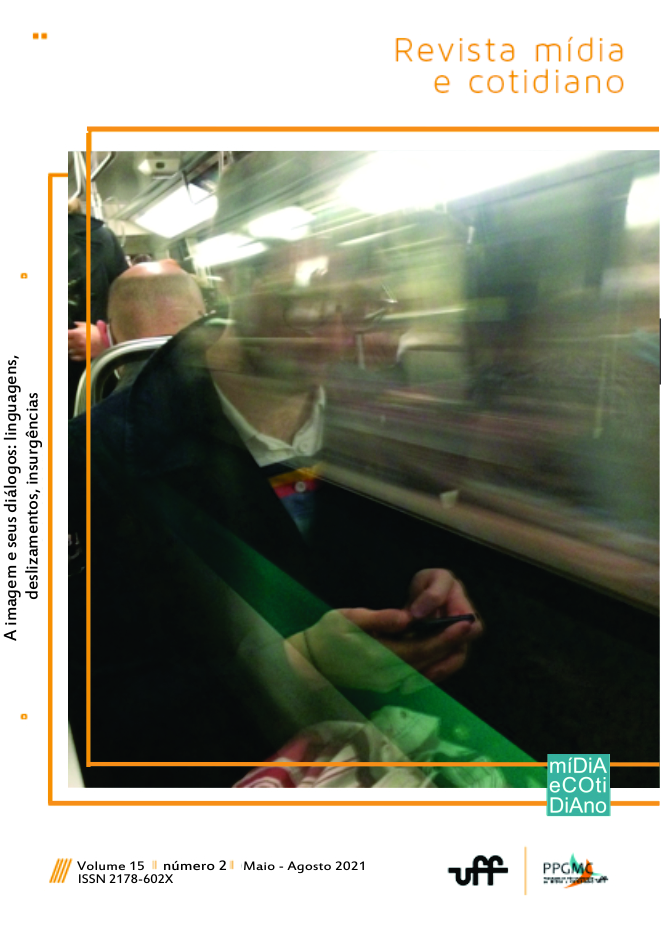When everything burns: uprisings, violence, image
DOI:
https://doi.org/10.22409/rmc.v15i2.48844Keywords:
Uprisings, Violence, Image, Racism, PhotographyAbstract
This article aims to analyze the aesthetic and political dimensions of photographic images of the anti-racist acts and protests that took place in 2020. The objective is to discuss the different figures of violence in the images of protests of the movement #blacklivesmatter and the mobilizations for Black Awareness Day in Brazil, seeking to observe: the experience of violence as motivation of the insurgencies, the violence underlying the gestures of upheaval, the violence undertaken to suppress the uprisings and, finally, the percussive force of the images. Taking these images into account means, from a methodological point of view, not only to criticize the uprisings, but also to propose a criticism of the violence and the way the images operate in the face of the powers and forms of power that cross these manifestations in different directions. The images under analysis, chosen based on their wide circulation, were responsible for synthesizing the emotions of the revolt and witnessing, from the eye of history, the moments when the monopoly of violence is exercised and also put to the test, in which the violence is opposed to violence itself, in which everything burns and the pathos of indignation is not only represented, but also visually expressed.
Downloads
References
BADIOU, Alain. The rebirth of history: Times of riots and uprisings. London, New York: Verso Books, 2012.
BALIBAR, Étienne. Violencia, política, civilidad. Ciencia Política, v. 10, n. 19, p. 45-67, 2015.
BENJAMIN, Walter. Crítica da violência: crítica do poder. In: BENJAMIN, Walter. Documentos de cultura, documentos de barbárie: escritos escolhidos. São Paulo: Cultrix; Editora da Universidade de São Paulo, p. 160-175, 1986.
BLACK LIVES MATTER GLOBAL NETWORK FOUNDATION. Black Lives Matter, [2020]. Herstory. Disponível em: https://blacklivesmatter.com/herstory/. Acesso em: 14 fev. 2021.
BUTLER, J. Levante. In: DIDI-HUBERMAN, G. Levantes. São Paulo: Sesc, 2017, p. 23-36.
BUTLER, Judith. Corpos em aliança e a política das ruas: notas para uma teoria performativa de assembleia. Rio de Janeiro: Civilização Brasileira, 2018.
DIDI-HUBERMAN, G. Levantes. São Paulo: Sesc-SP, 2017a.
_______. Através dos desejos (fragmentos sobre o que nos subleva). In: DIDI-HUBERMAN, G. Levantes. São Paulo: Sesc-SP, 2017b, p. 289-383.
_______. Désirer désobéir: Ce qui nous soulève, 1. Paris: Minuit, 2019.
FANON, Frantz. Os condenados da terra. Rio de Janeiro: Civilização Brasileira, 1968.
JINKNSS, Nay. 3° ep − Atemporalidade. São Paulo, 12 jun. 2020. Instagram: @nayjinknss. Disponível em: https://www.instagram.com/p/CBWuixUBx-O/. Acesso em: 20 fev. 2021.
LAUGIER, Sandra; OGIEN, Albert. Pourquoi désobéir en démocratie? Paris: La Découverte, 2011.
NANCY, Jean-Luc. Image et violence. Le Portique. Revue de philosophie et de sciences humaines, n. 6, p. 1-11, 2000.
RANCIÈRE, Jacques. O espectador emancipado. São Paulo: WMF Martins Fontes, 2012.
RANCIÈRE, Jacques. Um levante pode esconder outro. In: DIDI-HUBERMAN, G. Levantes. São Paulo: Sesc-SP, 2017, p. 63-70.
SARTRE, Jean-Paul. Prefácio. In: FANON, Frantz. Os condenados da terra. Rio de Janeiro: Civilização Brasileira, 1968.
SCHWARTE, Ludger. THE PEOPLE-IMAGE: the political philosophy of georges didi-huberman. Angelaki, v. 23, n. 4, p. 80-90, 2018.
SILVA, Sérgio; BREDA, Tadeu. Memória ocular: cenas de um estado que cega. São Paulo: Elefante, 2018.
Downloads
Published
How to Cite
Issue
Section
License
Aviso de Direito Autoral Creative Commons
1. Política para Periódicos de Acesso Livre
Autores que publicam nesta revista concordam com os seguintes termos:- Autores mantém os direitos autorais e concedem à revista o direito de primeira publicação, com o trabalho simultaneamente licenciado sob a Licença Creative Commons Attribution que permite o compartilhamento do trabalho com reconhecimento da autoria e publicação inicial nesta revista.
- Autores têm autorização para assumir contratos adicionais separadamente, para distribuição não-exclusiva da versão do trabalho publicada nesta revista (ex.: publicar em repositório institucional ou como capítulo de livro), com reconhecimento de autoria e publicação inicial nesta revista.
- Autores têm permissão e são estimulados a publicar e distribuir seu trabalho online (ex.: em repositórios institucionais ou na sua página pessoal) a qualquer ponto antes ou durante o processo editorial, já que isso pode gerar alterações produtivas, bem como aumentar o impacto e a citação do trabalho publicado (Veja O Efeito do Acesso Livre).


